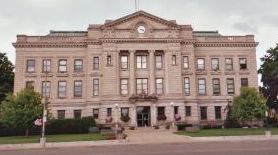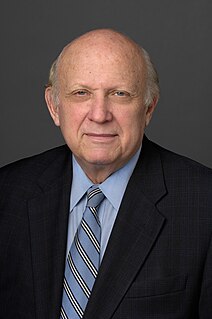West Virginia State Board of Education v. Barnette, 319 U.S. 624 (1943), is a landmark decision by the United States Supreme Court holding that the Free Speech Clause of the First Amendment protects students from being forced to salute the American flag or say the Pledge of Allegiance in public school. The Court's 6–3 decision, delivered by Justice Robert H. Jackson, is remembered for its forceful defense of free speech and constitutional rights generally as being placed "beyond the reach of majorities and officials".
Schenck v. United States, 249 U.S. 47 (1919), was a landmark United States Supreme Court case concerning enforcement of the Espionage Act of 1917 during World War I. A unanimous Supreme Court, in an opinion by Justice Oliver Wendell Holmes Jr., concluded that defendants who distributed fliers to draft-age men, urging resistance to induction, could be convicted of an attempt to obstruct the draft, a criminal offense. The First Amendment did not alter the well-established law in cases where the attempt was made through expressions that would be protected in other circumstances. In this opinion, Holmes said that expressions which in the circumstances were intended to result in a crime, and posed a "clear and present danger" of succeeding, could be punished.
New York Times Co. v. United States, 403 U.S. 713 (1971), was a landmark decision by the United States Supreme Court on the First Amendment. The ruling made it possible for The New York Times and The Washington Post newspapers to publish the then-classified Pentagon Papers without risk of government censorship or punishment.
Baker v. Carr, 369 U.S. 186 (1962), was a landmark United States Supreme Court case that decided that redistricting issues present justiciable questions, thus enabling federal courts to intervene and to decide redistricting cases. The defendants unsuccessfully argued that redistricting of legislative districts is a "political question", and hence not a question that may be resolved by federal courts.
Loving v. Virginia, 388 U.S. 1 (1967), was a landmark decision of the U.S. Supreme Court which struck down all state laws banning interracial marriage as violations of the Equal Protection and Due Process Clauses of the Fourteenth Amendment to the U.S. Constitution. The case was brought by Mildred Loving (née Jeter), a woman of color, and Richard Loving, a white man, who had been sentenced to a year in prison in Virginia for marrying each other. Their marriage violated Virginia's anti-miscegenation statute, the Racial Integrity Act of 1924, which criminalized marriage between people classified as "white" and people classified as "colored".
Whitney v. California, 274 U.S. 357 (1927), was a United States Supreme Court decision upholding the conviction of an individual who had engaged in speech that raised a threat to society.

The Judiciary Act of 1789 was a United States federal statute adopted on September 24, 1789, in the first session of the First United States Congress. It established the federal judiciary of the United States. Article III, Section 1 of the Constitution prescribed that the "judicial power of the United States, shall be vested in one supreme Court, and such inferior Courts" as Congress saw fit to establish. It made no provision for the composition or procedures of any of the courts, leaving this to Congress to decide.
Branzburg v. Hayes, 408 U.S. 665 (1972), is a landmark United States Supreme Court decision invalidating the use of the First Amendment as a defense for reporters summoned to testify before a grand jury. The case was argued February 23, 1972 and decided June 29 of the same year. The reporter lost his case by a vote of 5-4. This case is cited for the rule that in federal courts, a reporter may not generally avoid testifying in a criminal grand jury, and it remains the only case in which the U.S. Supreme Court has considered the use of reporters' privilege.
First National Bank of Boston v. Bellotti, 435 U.S. 765 (1978), is a U.S. constitutional law case which defined the free speech right of corporations for the first time. The United States Supreme Court held that corporations have a First Amendment right to make contributions to ballot initiative campaigns. The ruling came in response to a Massachusetts law that prohibited corporate donations in ballot initiatives unless the corporation's interests were directly involved.

Stump v. Sparkman, 435 U.S. 349 (1978), is the leading United States Supreme Court decision on judicial immunity. It involved an Indiana judge who was sued by a young woman who had been sterilized without her knowledge as a minor in accordance with the judge's order. The Supreme Court held that the judge was immune from being sued for issuing the order because it was issued as a judicial function. The case has been called one of the most controversial in recent Supreme Court history.
Northern Pipeline Construction Company v. Marathon Pipe Line Company, 458 U.S. 50 (1982), is a United States Supreme Court case in which the Court held that Article III jurisdiction could not be conferred on non-Article III courts.

In the United States, judicial review is the ability of a court to examine and decide if a statute, treaty or administrative regulation contradicts or violates the provisions of existing law, a State Constitution, or ultimately the United States Constitution. While the U.S. Constitution does not explicitly define a power of judicial review, the authority for judicial review in the United States has been inferred from the structure, provisions, and history of the Constitution.
Day v. McDonough, 547 U.S. 198 (2006), is a United States Supreme Court case involving the one year statute of limitations for filing habeas corpus petitions that was established by the Antiterrorism and Effective Death Penalty Act of 1996 (AEDPA). In a 5-4 decision, the Court ruled that where the government has unintentionally failed to object to the filing of a petition after the AEDPA limitations period has expired, it is not an abuse of discretion for a district court to nevertheless sua sponte dismiss the petition on that basis.
Massachusetts v. Environmental Protection Agency, 549 U.S. 497 (2007), is a 5-4 U.S. Supreme Court case in which twelve states and several cities of the United States brought suit against the Environmental Protection Agency (EPA) to force that federal agency to regulate carbon dioxide and other greenhouse gases (GHGs) as pollutants.
United States v. 12 200-ft. Reels of Film, 413 U.S. 123 (1973), was an in rem case decided by the United States Supreme Court that considered the question of whether the First Amendment required that citizens be allowed to import obscene material for their personal and private use at home, which was already held to be protected several years earlier. By a 5–4 margin, the Court held that it did not.
Quantity of Books v. Kansas, 378 U.S. 205 (1973), is an in rem United States Supreme Court decision on First Amendment questions relating to the forfeiture of obscene material. By a 7–2 margin, the Court held that a seizure of the books was unconstitutional, since no hearing had been held on whether the books were obscene, and it reversed a Kansas Supreme Court decision that upheld the seizure.
Marcus v. Search Warrant, 367 U.S. 717 (1961), full title Marcus v. Search Warrant of Property at 104 East Tenth Street, Kansas City, Missouri, is an in rem case decided by the United States Supreme Court on the seizure of obscene materials. The Court unanimously overturned a Missouri Supreme Court decision upholding the forfeiture of hundreds of magazines confiscated from a Kansas City wholesaler. It held that both Missouri's procedures for the seizure of allegedly obscene material and the execution of the warrant itself violated the Fourth and Fourteenth amendments' prohibitions on search and seizure without due process. Those violations, in turn, threatened the rights protected by the First Amendment.
NAACP v. Button, 371 U.S. 415 (1963), is a 6-to-3 ruling by the Supreme Court of the United States which held that the reservation of jurisdiction by a federal district court did not bar the U.S. Supreme Court from reviewing a state court's ruling, and also overturned certain laws enacted by the state of Virginia in 1956 as part of the Stanley plan and massive resistance, as violating the First and Fourteenth Amendments to the United States Constitution. The statutes here stricken down by the Supreme Court had expanded the definitions of the traditional common law crimes of barratry, champerty, and maintenance and had been targeted at the NAACP and its civil rights litigation.
Richmond Newspapers Inc. v. Virginia, 448 U.S. 555 (1980), is a United States Supreme Court case involving issues of privacy in correspondence with the First Amendment to the United States Constitution, the freedom of the press, the Sixth Amendment to the United States Constitution and the Fourteenth Amendment to the United States Constitution. After a murder case ended in three mistrials, the judge closed the fourth trial to the public and the press. On appeal, the Supreme Court ruled the closing to be in violation of the First Amendment and Fourteenth Amendment asserting that the First Amendment implicitly guarantees the press access to public trials.








